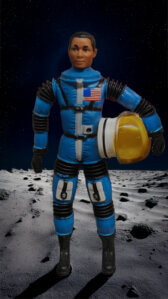Uncategorized
The importance of Jeff Long, the Science Officer of the Matt Mason Space action figures
In the mid-1960s, as the space race between the United States and the Soviet Union captured the world’s imagination, toy companies looked to the stars for inspiration. To compete with Hasbro’s wildly successful G.I. Joe, Mattel launched its own line of action figures—this time set not on the battlefield, but on the surface of the moon.
Enter Major Matt Mason, Mattel’s “Man in Space.” Dressed in a NASA-inspired Moon Suit with articulated arms and high-tech accessories like a Space Sled and Jet Propulsion Pack, Major Mason embodied the boundless possibilities of space exploration. First released in 1966, the toy line was an immediate hit with boomer kids captivated by the promise of the final frontier.
Each astronaut was made of a wire-framed rubber material called Plastizol, painted in bright colors and outfitted with removable helmets. The crew expanded to include a small team:
• Major Matt Mason (team leader, white suit)
• Sgt. Storm (red suit)
• Doug Davis (yellow suit)
• Lt. Jeff Long, (blue suit)
Alien friends and villains were later introduced to keep interest high, but the line was ultimately discontinued in 1970, cited as losing favor among the core audience.
A Bold Step in Representation

Second in command, Lt. Jeff Long was eventually added in 1968 during the height of the Civil Rights Movement—a time when calls for racial equality, representation, and inclusion were echoing through every corner of American society, from classrooms to lunch counters to television screens. While Mattel never released a formal statement explaining the decision, the timing suggests intent.
Here’s why Jeff Long mattered—and still does:
Reflecting a Changing America
By the late 1960s, Black Americans were demanding not just civil rights, but visibility. Including a black astronaut action figure to the team of white peers was subtle, but powerful—it acknowledged Black children as part of America’s future.
A Vision of Inclusion
The Major Matt Mason line was aspirational, envisioning a future beyond Earth much like the Star Trek series on TV. Featuring a Black astronaut wasn’t just a gesture—it was a quiet declaration that the future should belong to everyone.
A Rare Positive Role Model
At a time when most Black characters in toys and media were either absent or steeped in stereotype, Jeff Long offered something different: competence, intelligence, and heroism. He was a science officer. A specialist. A leader.
Smart Business Meets Social Progress
Mattel recognized that diverse characters not only reflected reality, they also resonated with a broader audience. For Black families looking for affirmation in children’s products, Jeff Long stood out. A commercial was created showing a black and a white child playing with the toys together. https://youtu.be/foWwW1_CFw4?si=ci2IyAGXZM-kab9X
Why It Still Matters Today
Lt. Jeff Long was more than a toy. For many children in the 1960s, especially Black children, he represented possibility—proof that they could dream as big as the moon. It’s worth noting that Guion Bluford, the first African-American astronaut to reach space, wouldn’t orbit Earth until 1983—nearly two decades later. Between the end of Apollo and the start of the Space Shuttle program, there was a long gap in U.S. manned space missions. But imagination never paused.
And that’s where toys like Jeff Long stepped in—filling cultural and emotional space until reality could catch up.
DEI Under Fire: A Look Back to Look Forward
Fast forward to today, and conversations around diversity, equity, and inclusion have once again taken center stage—though now, they’re often contested. Across the United States, there’s a growing movement to either limit or dismantle DEI programs in schools, workplaces, and even government institutions. Opponents of these efforts argue that they create division, while supporters believe they address long-standing imbalances.
But what happens when we lose sight of representation—when we forget why it mattered in the first place?
The story of the Jeff Long action figure toy offers a quiet but profound reminder: inclusion isn’t a trend or a threat—it’s a promise. A promise that everyone belongs in the story we’re telling, whether that story takes place on Earth, on the moon, or in the dreams of a child holding a blue-suited action figure in 1968.
In a moment when DEI is being challenged, maybe it’s time to revisit what progress actually looks like—and how even the smallest gestures, like adding a Black science officer to a toy line, can shape minds and futures in ways that statistics and policies never could.
The Matt Mason line of action figures are now valued collectors item. For this and other topic more reading on the subject is avalable.
https://www.fastcompany.com/90373166/meet-matt-mason-the-mattel-toy-which-brought-space-to-life-for-boomer-kids-and-then-disappeared
https://13thdimension.com/blast-off-with-these-13-majorly-cool-major-matt-mason-items/
https://www.nytimes.com/2022/07/18/business/mattel-major-matt-mason.html
Work that is representative of this character here.

